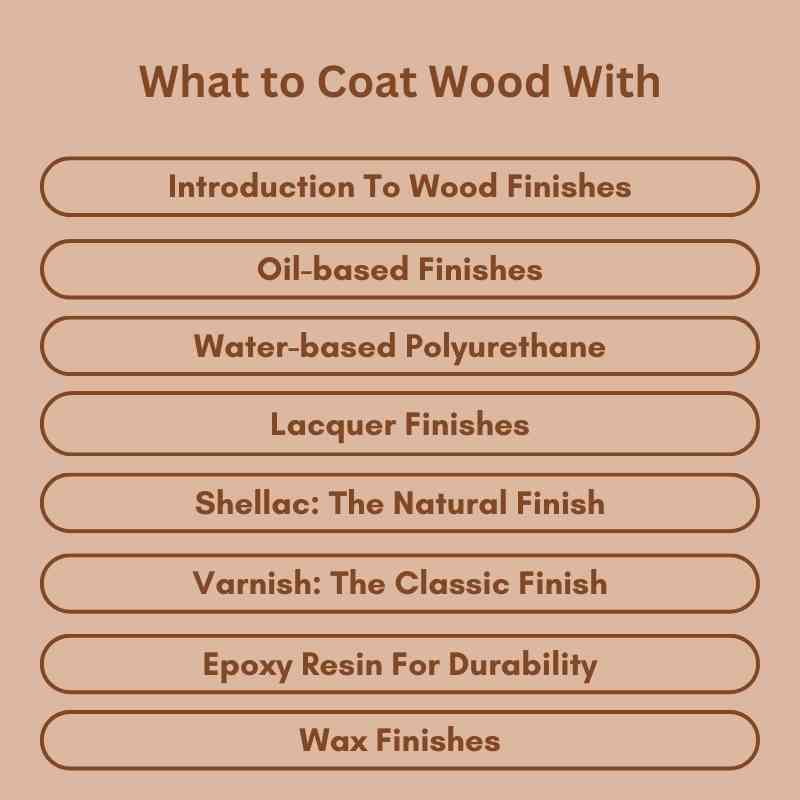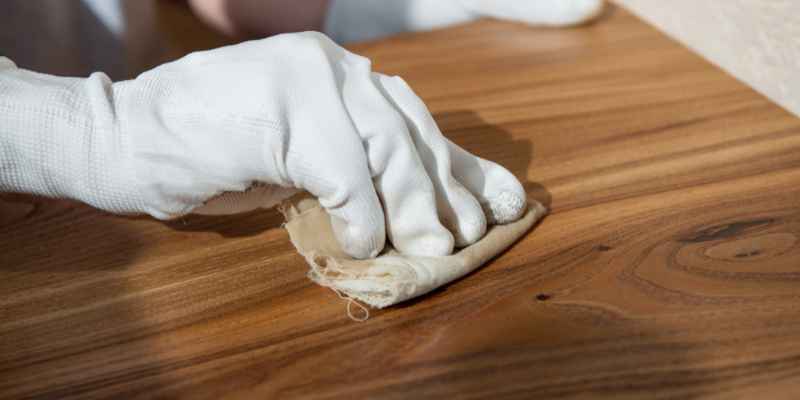To coat wood, use options like oil-based finishes, water-based finishes, or polyurethane. Each choice provides protection and enhances the wood’s natural beauty.
Coating wood is essential for preserving its integrity and appearance. Various products are available, each offering unique benefits. Oil-based finishes penetrate deeply, providing durability and a rich finish. Water-based finishes dry quickly and emit fewer odors, making them ideal for indoor projects.
Polyurethane creates a hard, protective layer, safeguarding against scratches and moisture. Choosing the right coating depends on the wood type and the intended use. Proper preparation and application techniques are crucial for achieving the best results. This guide will help you understand your options and make informed decisions for your wood projects.
Introduction To Wood Finishes
Wood needs protection to last longer and look better. It can be damaged by moisture, UV rays, and insects. Proper finishes help prevent these issues. They also enhance the wood’s natural beauty.
Many types of wood finishes exist. Each has unique features and benefits. Oil finishes penetrate wood, offering a rich look. Varnish provides a hard shell, ideal for high-traffic areas. Lacquer dries quickly and gives a smooth finish. Shellac is easy to apply and repair.
Choosing the right finish depends on the wood type and its use. A durable finish is key for outdoor projects. For indoor items, a beautiful finish can enhance the wood’s character.

Oil-based Finishes
Oil-based finishes offer several advantages for wood protection. They provide a strong, durable surface. These finishes enhance the natural beauty of the wood grain.
Common benefits include:
- Long-lasting protection against wear and tear.
- Water-resistant properties.
- Rich, deep color enhancement.
- Easy to apply and maintain.
Some popular oil finishes for wood are:
| Finish Type | Description |
|---|---|
| Linseed Oil | Natural oil that penetrates wood deeply. |
| Tung Oil | Provides a hard, protective finish. |
| Teak Oil | Ideal for outdoor furniture. |
Water-based Polyurethane
Water-based polyurethane is a popular choice for wood finishing. It dries quickly and offers a clear, durable coat. This type of finish is low in odors and is safe for indoor use. It provides a strong barrier against moisture and stains.
For the best results, prepare the wood surface well. Sand it smoothly to remove any imperfections. Apply the polyurethane with a high-quality brush or roller. Use thin coats and allow each coat to dry completely. Lightly sand between coats for a smooth finish.
| Tip | Description |
|---|---|
| Surface Prep | Sand the wood to a smooth finish. |
| Application | Use a high-quality brush or roller. |
| Coats | Apply thin coats and let them dry. |
| Sanding | Lightly sand between each coat. |
Lacquer Finishes
Lacquer finishes are popular for their smooth, glossy look. They dry quickly and create a hard surface. This makes them great for protecting wood.
Why choose lacquer? It offers excellent durability and resistance to scratches. Lacquer also enhances the natural beauty of the wood. Many people love its shiny finish.
Application techniques for lacquer are important for best results. Start by sanding the wood surface to make it smooth. Use a brush or spray gun for even application. Apply thin coats to avoid drips. Allow each coat to dry before adding another.
Shellac: The Natural Finish
Shellac is a great natural finish for wood. It comes from the secretions of the lac bug. This finish offers several benefits, making it popular among woodworkers.
- Easy to Apply: Shellac dries quickly and can be applied easily.
- Natural Look: It enhances the beauty of the wood grain.
- Non-Toxic: Safe for indoor use, especially around children and pets.
- Versatile: Works well on various types of wood.
Applying shellac on wood is simple. Start by preparing the surface. Sand the wood to make it smooth. Use a brush or cloth to apply shellac. Make sure to apply thin coats. Allow each coat to dry before adding another. This helps create a nice finish.
Varnish: The Classic Finish
Varnish is a popular choice for finishing wood. It adds a protective layer and enhances beauty. Comparing varnish to other finishes shows its unique benefits. While oil-based finishes penetrate wood, varnish creates a strong surface. Water-based options dry faster but may not be as durable.
For the best results, follow these tips for applying varnish:
- Choose a clean, dry surface.
- Use a high-quality brush or spray.
- Apply in thin, even coats.
- Sand between coats for smoothness.
- Allow sufficient drying time.
Epoxy Resin For Durability
Epoxy resin is a popular choice for coating wood. It provides excellent durability and a beautiful finish. This resin creates a strong barrier against moisture and damage.
Some key advantages include:
- Water-resistant properties protect wood from rot.
- Scratch-resistant surface keeps wood looking new.
- UV protection prevents fading over time.
- Easy to clean and maintain.
Mixing epoxy resin is simple. Combine the resin and hardener according to the instructions. Stir until it looks clear.
Applying epoxy resin is easy. Use a brush or roller for an even coat. Allow it to cure fully for the best results.
Wax Finishes
Wax finishes are a popular choice for wood. They add a beautiful shine. Wax is easy to apply and maintain. It also protects the wood from moisture. Wax creates a warm and natural look.
The charm of wax finishes lies in their simplicity. They enhance the wood’s natural grain. Different wax types are available, such as beeswax and carnauba. Each type offers a unique finish.
To apply wax for lasting protection, follow these steps:
- Start with clean, dry wood.
- Use a soft cloth to apply the wax.
- Rub the wax in circular motions.
- Let it dry for 10-15 minutes.
- Buff the surface with a clean cloth.
This method ensures a smooth and shiny finish. Regular reapplication keeps the wood looking great.
Choosing The Right Finish
Choosing the right finish for wood involves several key factors. Durability is one of the most important aspects. Different finishes offer varying levels of protection against wear and tear.
Consider the environment where the wood will be used. Indoor and outdoor settings require different finishes. Outdoor finishes need to withstand moisture and UV rays.
| Finish Type | Durability Level |
|---|---|
| Polyurethane | High |
| Varnish | Medium |
| Oil | Low |
| Shellac | Low |
Consider the appearance of the finish as well. Some finishes enhance the wood’s natural beauty. Others can change its color completely.
Lastly, think about the ease of application. Some finishes require special skills or tools. Others can be applied easily at home.

Frequently Asked Questions
What Is The Best Finish For Wood?
The best finish for wood depends on its use and desired appearance. Common options include polyurethane, varnish, and oil. Polyurethane offers durability, while oil provides a natural look. Consider the environment and maintenance when choosing the finish for optimal results.
Can I Use Paint On Wood?
Yes, you can use paint on wood. It provides a colorful, protective layer. Choose a high-quality exterior or interior paint based on your project. Always prepare the surface properly by sanding and priming for the best adhesion and finish.
How Often Should I Recoat Wood?
Recoating wood depends on the type of finish and exposure. Typically, every 2 to 5 years is recommended for outdoor wood. Indoor wood may need less frequent maintenance. Regular inspection helps determine if recoating is necessary to maintain protection and appearance.
Is Oil Better Than Polyurethane For Wood?
Oil and polyurethane each have unique benefits. Oil penetrates deeply and enhances natural grain, while polyurethane offers superior protection against moisture and wear. Choose oil for a natural finish and polyurethane for durability. Your choice should align with your project’s needs.
Conclusion
Choosing the right coating for wood is essential for its longevity and beauty. Each option offers unique benefits, from protection to aesthetics. Whether you prefer oil, polyurethane, or varnish, consider your specific needs. With the right finish, your wood can withstand the test of time while enhancing its natural charm.

